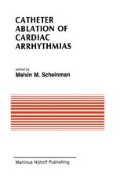Abstract
Myocardial ablation is a new therapeutic option for arrhythmia management. High-energy electrical ablation has been successfully applied to the atrium [1], atrioventricular node [2–6], and accessory pathways [7, 8] for control of automatic and reentrant supraventricular tachycardias. More recently, ventricular ectopic foci have been ablated using high-energy electrical shocks [9–15].
Dr. Levine is the recipient of a Clinician Scientist Research Award sponsored by the Johns Hopkins Medical Institutions.
Access this chapter
Tax calculation will be finalised at checkout
Purchases are for personal use only
Preview
Unable to display preview. Download preview PDF.
References
Silka MJ, Gillette PC, Garson A, Zinner A: Transvenous catheter ablation of a right atrial automatic ectopic tachycardia. JACC 5: 999, 1985.
Beazell J, Tan K, Criley J, Schulman J: The electrosurgical production of heart block without thoracotomy. Clin Res 24: 137A, 1976.
Scheinman MM, Morady F, Hess DS, Gonzalez R: Catheter-induced ablation of the atrial-ventricular function to control refractory supraventricular arrhythmias. JAMA 248: 851, 1982.
Gallagher JJ, Svenson RH, Kasell JH, German LD, Bardy GH, Broughton A, Critelli G: Catheter technique for closed chest ablation of the atrioventricular conduction system: A therapeutic alternative for the treatment of refractory supraventricular tachycardia. N Engl J Med 306: 194, 1984.
Trantham JL, Gallagher JJ, German LD, Broughton A, Guarnieri T, Kassel J: Effects of energy delivery via a His-bundle catheter during closed chest ablation of the atrioventricular conduction system. J Clin Invest 72: 1563, 1983.
Gonzales R, Scheinman MM, Margaretter W: Closed-chest electrode catheter technique for His-bundle ablation in dogs. Am J Physiol 241: H283, 1981.
Morady F, Scheinman MM: Transvenous catheter ablation of a posteroseptal accessory pathway in patient with the Wolff-Parkinson-White Syndrome. N Eng J Med 310: 705, 1984.
Brodman R, Fisher JD: Evaluation of a catheter technique for ablation of accessory pathways near the coronary sinus using a canine model. Circulation 67: 923, 1983.
Hartzler GO: Electrical catheter ablation of refractory focal ventricular tachycardia. JACC 2: 1107, 1983.
Winston SA, Davis JC, Morady F, DiCarlo LA, Matsubara T, Wexman MP, Scheinman MM: A new approach to electrode catheter ablation for ventricular tachycardia arising from the intraventricular septum. Circulation 70(Suppl II): 11–412, 1984.
Winston SA, Morady F, Davis JC, Di Carlo LA, Wexman MP, Scheinman MM: Catheter ablation of ventricular tachycardia. Circulation 70(Suppl II): 11–412, 1984.
Steinhaus D, Whilford E, Stavens C, Schneller S, McComb J, Carr J, McGovern B, Garan H, Ruskin J: Percutaneous transcatheter electrical ablation for recurrent sustained ventricular tachycardia. Circulation 70(Suppl II): 11–100, 1984.
Harztler GO, Giorgi LV: Electrode catheter ablation of refractory ventricular tachycardia. Continued experience (abstract) JACC 3: 512, 1984.
Ruffy R, Kim SS, Lal R: Paroxysmal fascicular tachycardia: Electrophysiologic characteristics and treatment by catheter ablation. J Am Coll Cardiol 5: 1008, 1985.
Belhassen B, Miller HI, Geller E, Laniado S: Transcatheter electrical shock ablation of ventricular tachycardia. JACC 7: 1347, 1986.
Lee BI, Gottdiener JS, Fletcher RD, Rodriguez ER, Ferrans VJ: Transcatheter ablation: Comparison between laser photoablation and electrode shock ablation in the dog. Circulation 71: 579, 1985.
Lerman BB, Weiss JL, Bulkley BH, Becker LC, Weisfeldt ML: Myocardial injury and induction of arrhythmia by direct current shock delivered via endocardial catheters in dogs. Circulation 69: 1006, 1984.
Westveer DC, Nelson T, Stewart JR, Thornton EP, Gordon S, Timmis GC: Sequelae of left ventricular electrical endocardial ablation, JACC 5: 956, 1985.
Kempf FC, Falcone RA, Marchlinski FE, Josephson ME: The electrophysiologic effects of high-energy electrical discharges in the ventricle (abstract) JACC 3(2): 554A.
Jones JL, Lepeschkin E, Jones RE, Rush S: Response of cultured myocytes to countershock-type electric field stimulation. Am J Physiol 235: H214, 1978.
Jones JL, Jones RE: Decreased defibrillator-induced dysfunction with biphasic rectangular wave forms. Am J Physiol 247: H792, 1984.
Jones JL, Jones RE: Improved defibrillator waveform safety factor with biphasic waveforms. Am J Physiol 245: H60, 1983.
Bailey JC, Spear JF, Moore EN: Microelectrode demonstration of Wedensky facilitation in canine cardiac Purkinje fibers. Circ Res 33: 48, 1973.
Levine JH, Spear JF, Weisman HF, Kadish AH, Prood C, Siu CO, Moore EN: The cellular electrophysiologic changes induced by high-energy electrical ablation in canine myocardium. Circulation 73: 818, 1986.
Fozzard HA: Conduction of the action potential. In: Handbook of Physiology. RM Berne, N Sperelakis, SR Geiger, eds. Wash DC: Am Physiol Soc, pp 335–392, 1979.
Spear JF, Moore EN: Supernormal excitability and conduction in the His-Purkinje system of the dog. Circ Res 35: 782, 1974.
Spear JF, Michelson EL, Moore EN: Reduced space constant in slowly conducting regions of chronically infarcted canine myocardium. Circ Res 53: 176, 1983.
Friedman R, Moak JP, Garson A: Endocardial catheter ablation of ventricular muscle induces arrhythmias: Reentry, abnormal automaticity and triggered activity (abstract) JACC 7(2): 38A, 1986.
Editor information
Editors and Affiliations
Rights and permissions
Copyright information
© 1988 Martinus Nijhoff Publishing, Boston
About this chapter
Cite this chapter
Levine, J.H., Spear, J.F., Merillat, J.C., Weisman, H.F., Kadish, A.H., Moore, E.N. (1988). Cellular Electrophysiology of Electrical Discharges. In: Scheinman, M.M. (eds) Catheter Ablation of Cardiac Arrhythmias. Developments in Cardiovascular Medicine, vol 78. Springer, Boston, MA. https://doi.org/10.1007/978-1-4613-1765-4_2
Download citation
DOI: https://doi.org/10.1007/978-1-4613-1765-4_2
Publisher Name: Springer, Boston, MA
Print ISBN: 978-1-4612-8990-6
Online ISBN: 978-1-4613-1765-4
eBook Packages: Springer Book Archive

